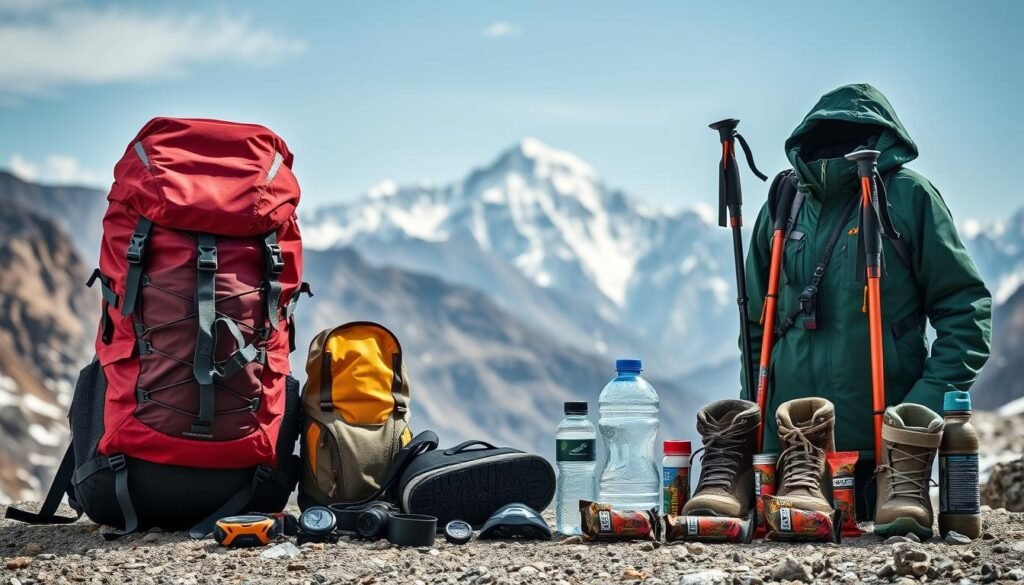Going on a Himalayan trek is a once-in-a-lifetime adventure. But, it needs careful preparation and the right gear. Packing the essentials is key for a successful and fun trek.
This guide covers everything from clothing layers to navigation tools. It helps you prepare for the Himalayas with confidence. Proper trekking preparation is vital for a safe and enjoyable trip, even in high-altitude areas.
Key Takeaways
- Pack layers for varying temperatures
- Choose comfortable and sturdy trekking boots
- Bring navigation tools and a first-aid kit
- Stay hydrated with a water purification system
- Prepare for emergencies with a personal locator beacon (PLB)
Understanding the Himalayan Environment
The Himalayan environment is both diverse and challenging. The climate changes a lot, needing careful planning. Trekkers must know the region’s geography and climate to move through the trails well.
Climate Variations Across Regions
The Himalayas cover a huge area, leading to different climates in each region. From the warm south to the cold north, it’s key to understand these changes for seasonal trekking. For example, the south gets a lot of rain during the monsoon, while the north stays dry.
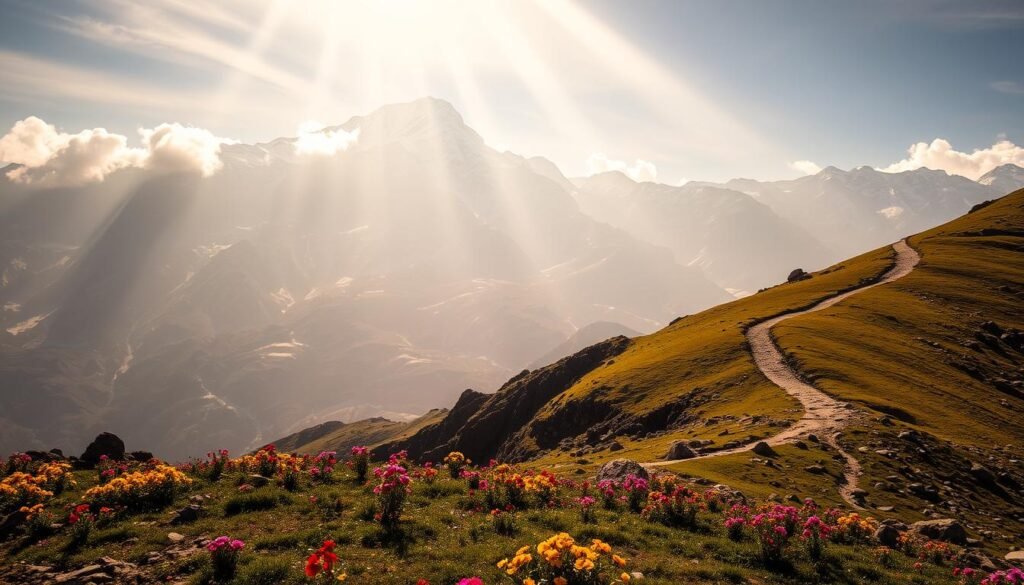
Altitude Challenges and Acclimatization
One big challenge in Himalayan trekking is altitude sickness. As you go up, the air gets thinner, and there’s less oxygen. It’s important to get used to the high altitudes slowly to avoid sickness. Trekkers should climb up little by little, letting their bodies adjust.
Seasonal Packing Considerations
Seasonal trekking in the Himalayas needs good planning and packing. You must think about the season and area you’ll be in to pack the right stuff. For example, in winter, you’ll need warm clothes and insulated gear. In the monsoon, waterproof items are a must.
What to Pack for a Himalayan Trek: The Complete Checklist
Before you start your Himalayan adventure, you need to pack right. You must know the basics of planning, how to pack smart, and what’s really needed.
Pre-Trek Planning and Research
Good planning starts with research. Learn about the terrain, weather, and dangers of the Himalayas. This helps you make a packing list that fits your trek.
Weight and Space Optimization
It’s important to pack light and smart. Choose multi-use items, wear layers, and use compression bags to save space.
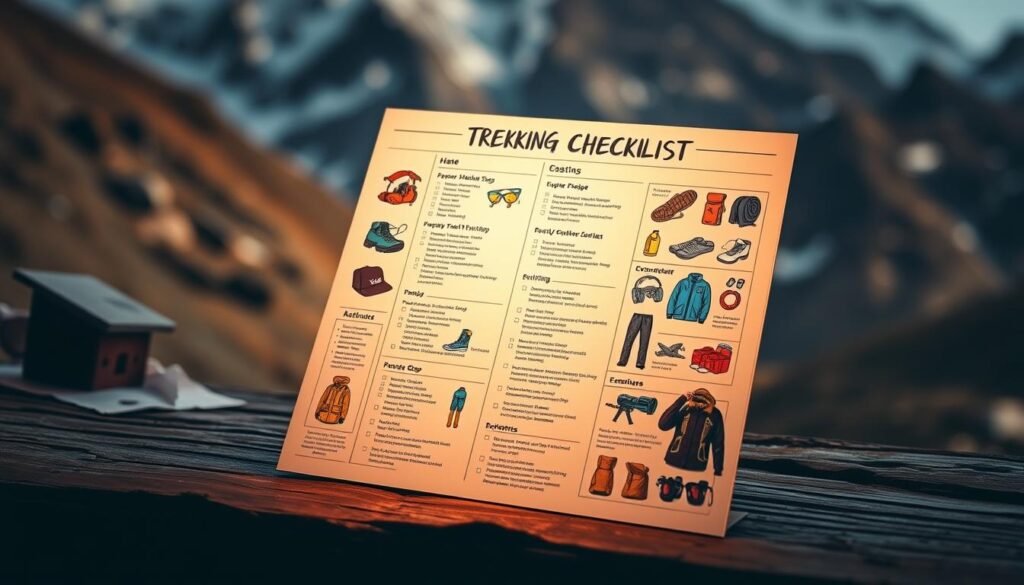
Essential vs. Optional Gear
Know the difference between essential and optional gear. Must-haves include a first aid kit, navigation tools, and the right clothes. Optional items are things like extra snacks or games.
By focusing on these areas, you’ll make a packing list that makes your trek better.
Essential Clothing Layers for Extreme Mountain Conditions
High-altitude treks are tough. You need the right clothes to stay safe and comfy. Learning how to layer your clothes is key.
Moisture-Wicking Base Layers
Base layers are the first step. They keep you dry by pulling sweat away. Merino wool and synthetic fabrics are top picks. They dry fast and keep you cool.
Insulating Mid-Layers for Warmth
Mid-layers keep you warm. Fleece and insulated jackets are great for this. Choose based on the weather and how breathable you need it.
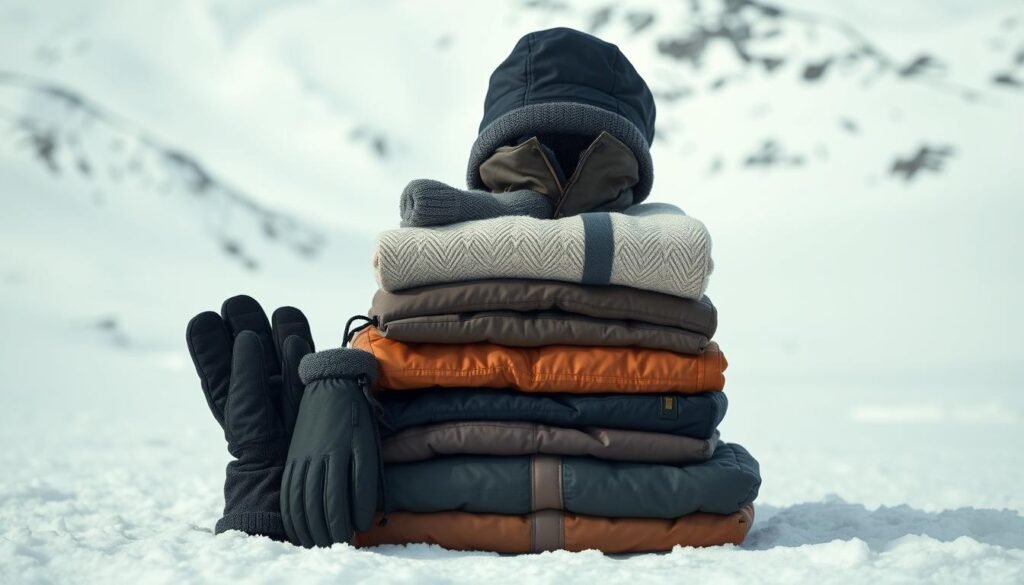
Weatherproof Outer Shells
The outer shell guards against wind, rain, and snow. Look for waterproof and breathable materials like Gore-Tex. This layer keeps you dry and safe.
Specialized Headwear and Gloves
Headwear and gloves stop heat loss. Thermal hats and insulated gloves or mittens are must-haves. For really cold weather, get gloves with waterproof membranes and warm liners.
Layering clothes right lets you adjust to changing weather. It’s all about staying warm, dry, and protected.
Footwear and Foot Care for Rugged Terrain
Trekking in rugged terrain needs more than just any shoes; it requires boots that are both tough and comfy. Taking care of your feet is key for a great trekking experience.
Selecting the Right Trekking Boots
Choosing the right trekking boots is vital for tough trails. Look for boots that are durable, waterproof, and have good ankle support. Waterproofing keeps your feet dry in wet weather. Adequate ankle support helps prevent sprains and injuries.
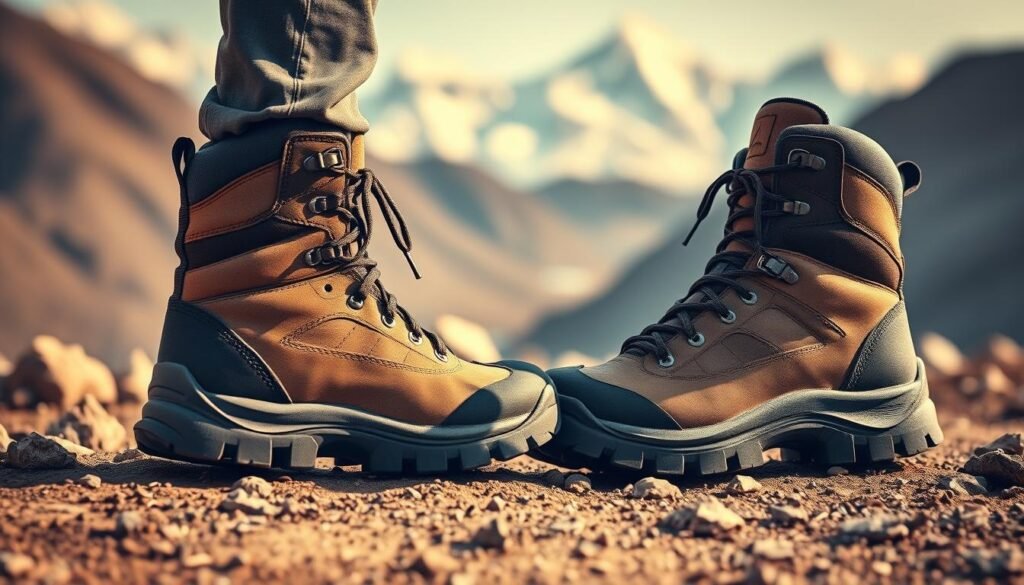
Strategic Sock Layering Systems
Sock layering is a simple yet effective way to keep your feet comfy. Use a thin, moisture-wicking base layer sock with a thicker, insulating outer sock. This combo prevents blisters and keeps your feet dry.
Blister Prevention and Treatment
Preventing blisters is key for a comfy trek. Make sure your boots and socks fit right, use blister prevention products like moleskin, and keep your feet dry. If you get a blister, clean it, apply a care product, and cover it to protect it.
Camp Shoes and Recovery Footwear
Having camp shoes or recovery footwear makes rest periods more comfortable. These lighter, more relaxed shoes help your feet recover from the day’s trek. This improves your overall trekking experience.
By focusing on these footwear and foot care tips, trekkers can prepare better for rugged terrain. This ensures a safer and more enjoyable journey.
Sleep Systems for High-Altitude Comfort
Trekking in the Himalayas requires a good sleep system for rest and recovery. A good night’s sleep boosts your trekking performance and overall experience.
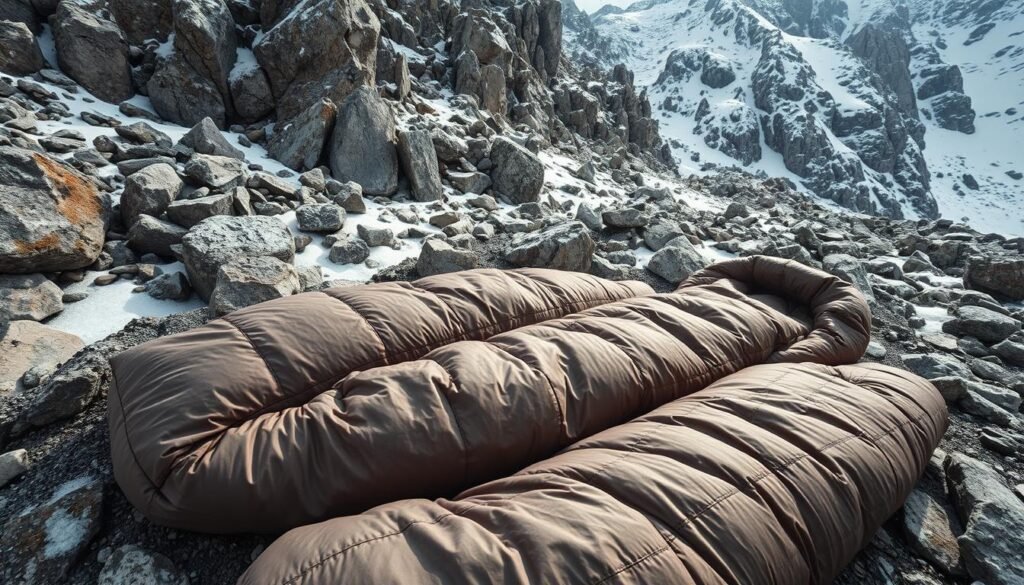
Cold-Weather Sleeping Bags
A high-quality sleeping bag is key for sub-zero temperatures. Choose a bag with a comfort rating for your trek’s low temperatures. Synthetic insulation is durable and water-resistant, while down insulation is warmer for its weight.
Insulating Sleeping Pads
Insulating sleeping pads add warmth and comfort. Inflatable pads are more comfortable and insulating. Foam pads are durable and reliable. Pick a pad with an R-value for your expected temperatures.
Sleeping Bag Liners and Accessories
Sleeping bag liners add warmth and hygiene. Silk or cotton liners are cozy and good for warmer nights. Camp pillows and eye masks can also improve sleep quality.
Tent Selection and Considerations
A good tent is essential for a restful night. Look for a waterproof, wind-resistant tent with good ventilation. Balance the tent’s size and weight with the number of occupants and weather.
As Renowned adventurer, Alex Honnold, once said,
The right gear can make or break your expedition. Investing in a good sleep system is crucial.
” This highlights the need for a well-chosen sleep system for comfort at high altitudes.
Backpacks and Packing Organization
Choosing the right expedition backpack is key for a great trek. A good backpack makes your journey comfortable and fun. It should be comfortable, easy to access, and durable.
Expedition Backpack Features
When picking a backpack, look for a 60-80 liter capacity. This size is perfect for Himalayan treks. Key features include a strong frame, comfy hip belt, and lots of compartments for organizing. Osprey and Deuter make top-notch backpacks for tough terrains and bad weather.
Waterproofing Your Gear
Keeping your gear dry is crucial. Use waterproof bags or dry sacks for clothes and electronics. Also, treat your backpack to make it more water-resistant.
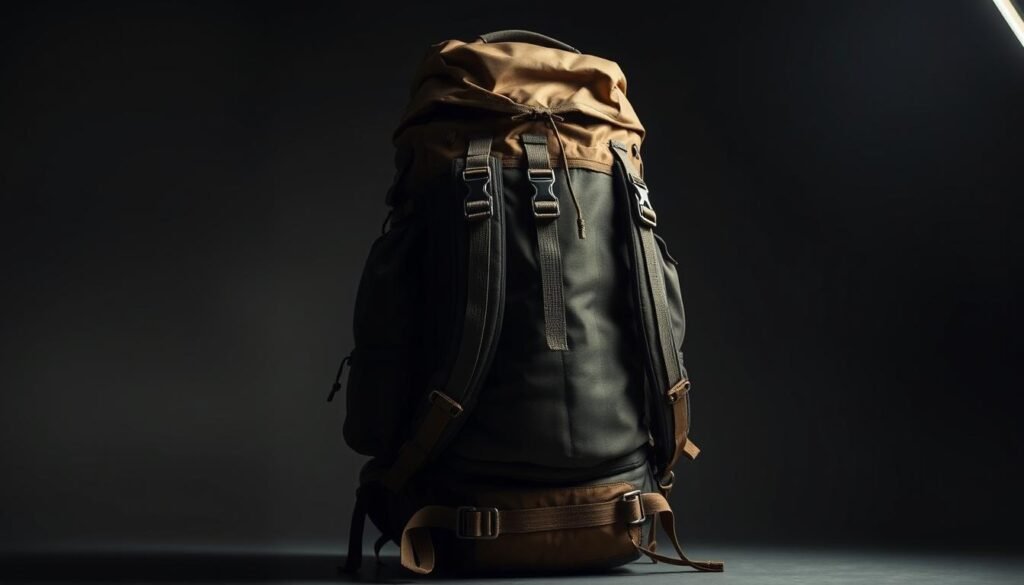
Compression and Organization Systems
Good compression and organization are key. Use compression straps to pack tight. Organize your stuff into groups (like clothes and electronics) for quick access.
Accessibility and Balance Techniques
Put heavy items near your back and easy-to-use items within reach. Use the backpack’s compartments to spread out the weight. This way, your gear is balanced and easy to get to.
By focusing on these tips, you can have a well-organized and comfy backpacking trip. This will make your Himalayan trek even more enjoyable.
Navigation and Safety Tools for Remote Trails
To ensure a safe and enjoyable trek in the Himalayas, it’s vital to be prepared with the right tools.
Navigating remote trails needs both old and new methods. The right gear can make all the difference between a good trek and a risky one.
Maps, Compass, and GPS Devices
A detailed topographic map, a reliable compass, and a GPS device are key for the Himalayas’ trails. While GPS devices are handy, don’t forget a map and compass. They don’t need batteries.
Key Features to Consider:
- Accuracy and reliability
- Battery life and backup power sources
- Water resistance and durability
Emergency Communication Options
In emergencies, having a way to communicate is crucial. Satellite phones and personal locator beacons (PLBs) are top choices for remote treks.
| Device | Features | Use Case |
|---|---|---|
| Satellite Phone | Voice communication, text messaging | Emergency calls, staying in touch with team members |
| PLB | Emergency signal transmission | Sending distress signals to emergency responders |
Trekking Poles and Stability Aids
Trekking poles can greatly improve stability on uneven terrain. They help prevent falls and injuries, making them great for steep or slippery areas.
Choosing the Right Trekking Poles: Look for poles that are lightweight, adjustable, and have comfortable grips.
Avalanche and Weather Safety Equipment
For treks in avalanche-prone areas, carrying avalanche safety gear is essential. This includes transceivers, probes, and shovels. Also, keep an eye on weather forecasts and be ready for sudden changes.
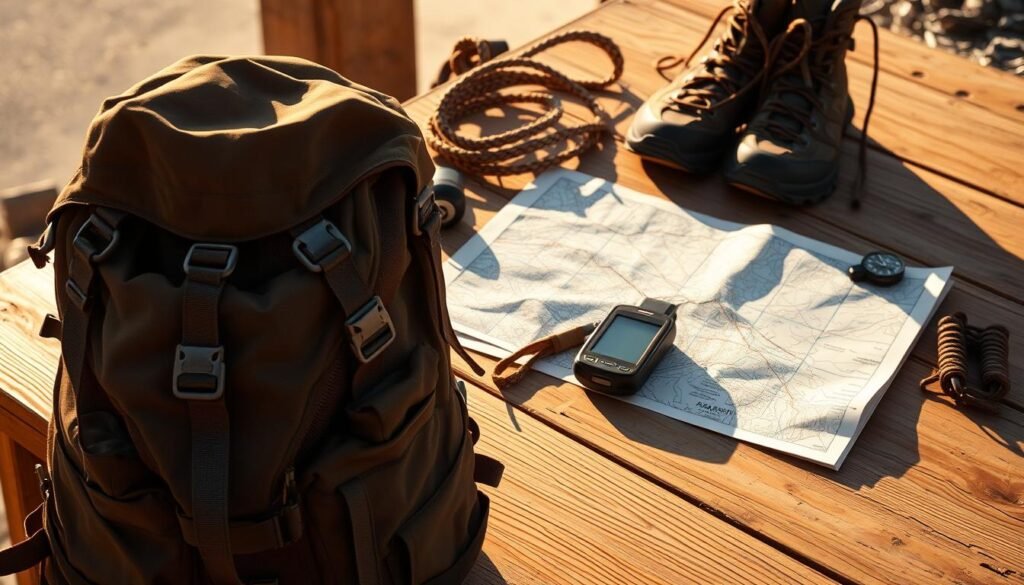
With the right tools, trekkers can enjoy the Himalayas safely and fully.
Health and First Aid Essentials
A good first aid kit and knowing about health basics are key for the Himalayas. The area is remote and high up, so medical help is far away. This makes it important to prevent and take care of yourself.
Altitude Sickness Prevention and Treatment
Altitude sickness, or Acute Mountain Sickness (AMS), is a big risk at high altitudes. To prevent it, climb slowly to get used to the height. Symptoms include headaches, nausea, and feeling tired.
Treatment means going down to a lower place. In serious cases, you might need medicine like Diamox.
Comprehensive First Aid Kit Components
Your first aid kit should have bandages, antiseptic wipes, pain relievers, and any personal meds. It’s smart to include Diamox for altitude sickness and stuff for blisters too.
| Item | Purpose |
|---|---|
| Bandages | Wound care |
| Antiseptic wipes | Infection prevention |
| Diamox | Altitude sickness treatment |
Personal Medications and Supplements
Bring any personal meds and think about supplements for altitude and health. Always talk to a doctor before you go.
Hygiene and Sanitation Products
Keeping clean is key to avoid getting sick. Hand sanitizer, biodegradable soap, and toilet paper are must-haves.
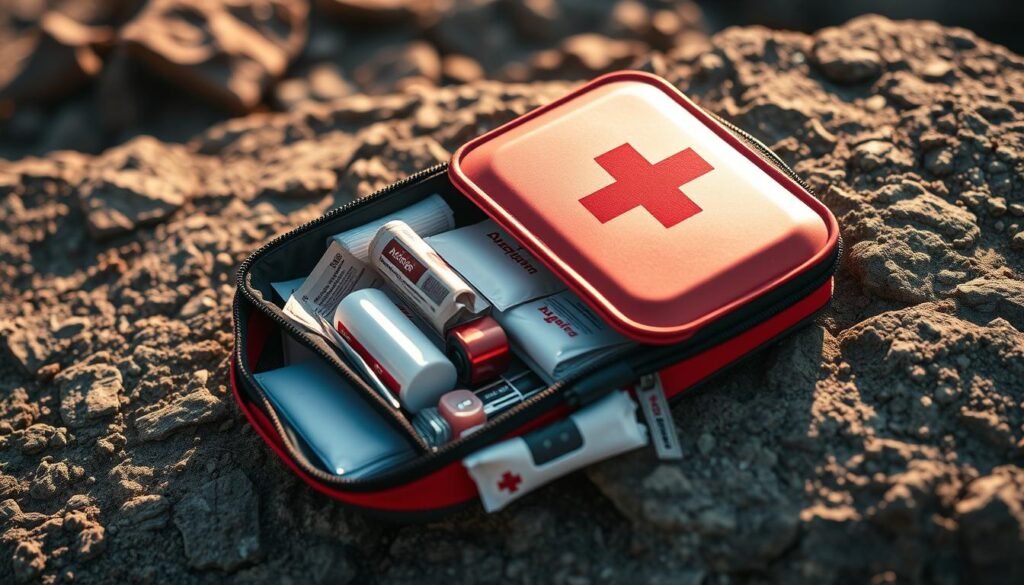
Being ready with the right health and first aid items can greatly lower risks in the Himalayas.
Food, Water, and Hydration Management
Staying hydrated and well-nourished is key in extreme mountain conditions. Trekking in the Himalayas requires careful planning of food and water. This ensures a safe and successful journey.
Water Purification Systems
Clean drinking water is essential. Water purification systems like filters, UV purifiers, or chemical treatments are crucial. They remove harmful contaminants and pathogens from water sources, making it safe to drink.
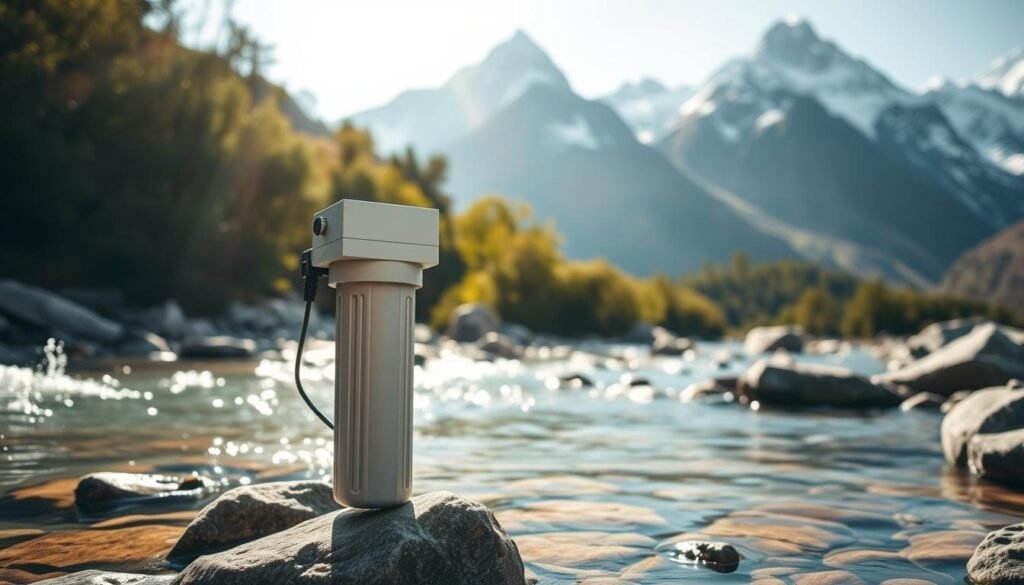
Hydration Bladders and Insulated Bottles
Hydration bladders make it easy to carry and drink water. Insulated bottles keep water from freezing in cold weather. This ensures you stay hydrated even in extreme conditions.
High-Energy Trail Foods
Eating high-energy foods is important to keep your energy up. Nuts, dried fruits, jerky, and energy bars are favorites among trekkers. These foods are rich in energy and light, perfect for long treks.
Cooking Equipment and Fuel
Having portable cooking equipment and efficient fuel is necessary for meals. Lightweight stoves and fuel canisters are best for their convenience and energy efficiency.
Good hydration management and nutrition planning are essential for a successful trek. By choosing the right water purification systems, hydration tools, high-energy foods, and cooking equipment, trekkers stay energized and hydrated on their journey.
Conclusion: Final Preparation and Packing Tips
Getting ready for your Himalayan trek is crucial for a great experience. This guide will help you pack the right gear for the Himalayan terrain. You’ll be ready for any challenge that comes your way.
Preparation is more than just packing. It’s about knowing the environment and potential dangers. Make sure your list includes everything from base layers to emergency tools.
Here are some packing tips for your Himalayan trek: Choose a comfortable backpack. Pack layers for different weather. And remember, a first aid kit and water purification system are must-haves. With the right planning and gear, your trek will be unforgettable.

